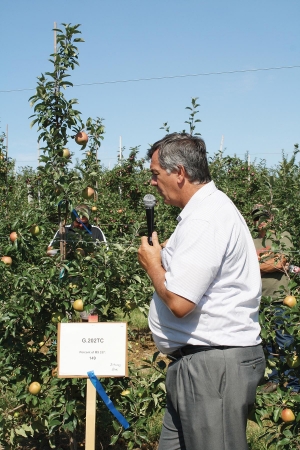
Terence Robinson looks over a Honeycrisp tree planted on a G. 202TC rootstock in Joe Rasch’s orchard. The TC indicates the root came from tissue culture. This tree is 149 percent of the size of the standard M.9 337, as determined by trunk diameter. Photo by Richard Lehnert.
The loss of a hillside of Gala trees in a big storm in 2009 opened up an opportunity for Michigan grower Joe Rasch to use that land to participate in a national trial evaluating Honeycrisp on 32 different rootstocks.
Rasch is collaborating with Dr. Terence Robinson, research horticulturist with Cornell University, New York, who is chair of the apple subcommittee of the NC-140 program that evaluates fruit rootstocks at some 20 sites across the northern United States and Canada.
A nationwide planting in 2010 is evaluating the performance of Honeycrisp in 15 locations. There are 150 trees in the Rasch trial. Now in their fourth leaf, “They’re starting to sort themselves out,” Rasch reported during the annual Ridgefest tour, which visited his Fruit Ridge orchard. Robinson said 15 million apple trees are planted in the United States every year. Growers make choices, and live with them for 20 or 30 years.
Honeycrisp is probably the most-planted apple today, and it has a host of problems. “Honeycrisp is weak-growing, biennial bearing, and subject to bitter pit,” Robinson said. “Can rootstock choice make a difference?”
The Budagovsky 9 rootstock, while less susceptible to fireblight than others, is too weak in most cases for Honeycrisp, he said. The Geneva rootstock G.30 has proven too brittle at the graft union. G.202 from tissue culture is about 150 percent of the vigor of M.9-337 and “looking pretty decent for Honeycrisp,” Robinson said. M.26 is bigger, but more susceptible to fireblight and replant disease. G.41, about 110 percent the size of M.9, has a million liners in the nursery this year and is becoming more widely used, but a brittle graft union makes a strong trellis necessary, he said.
Other rootstocks in the trials include several from Russia (Budagovsky series), Germany (Supporter series), and Cornell, as well as Malling rootstocks for comparison.
Robinson said he would like to evaluate the effects of rootstocks not just on dwarfing, cold hardiness, and production, but on such things as tolerance to problems like bitter pit, storage disorders, and flatness of branch angle.
Volunteers like Rasch help growers everywhere to make choices, but Rasch said it’s not all for charity. He finds himself in that plot of 150 trees looking for the best performers for his orchard.






Leave A Comment